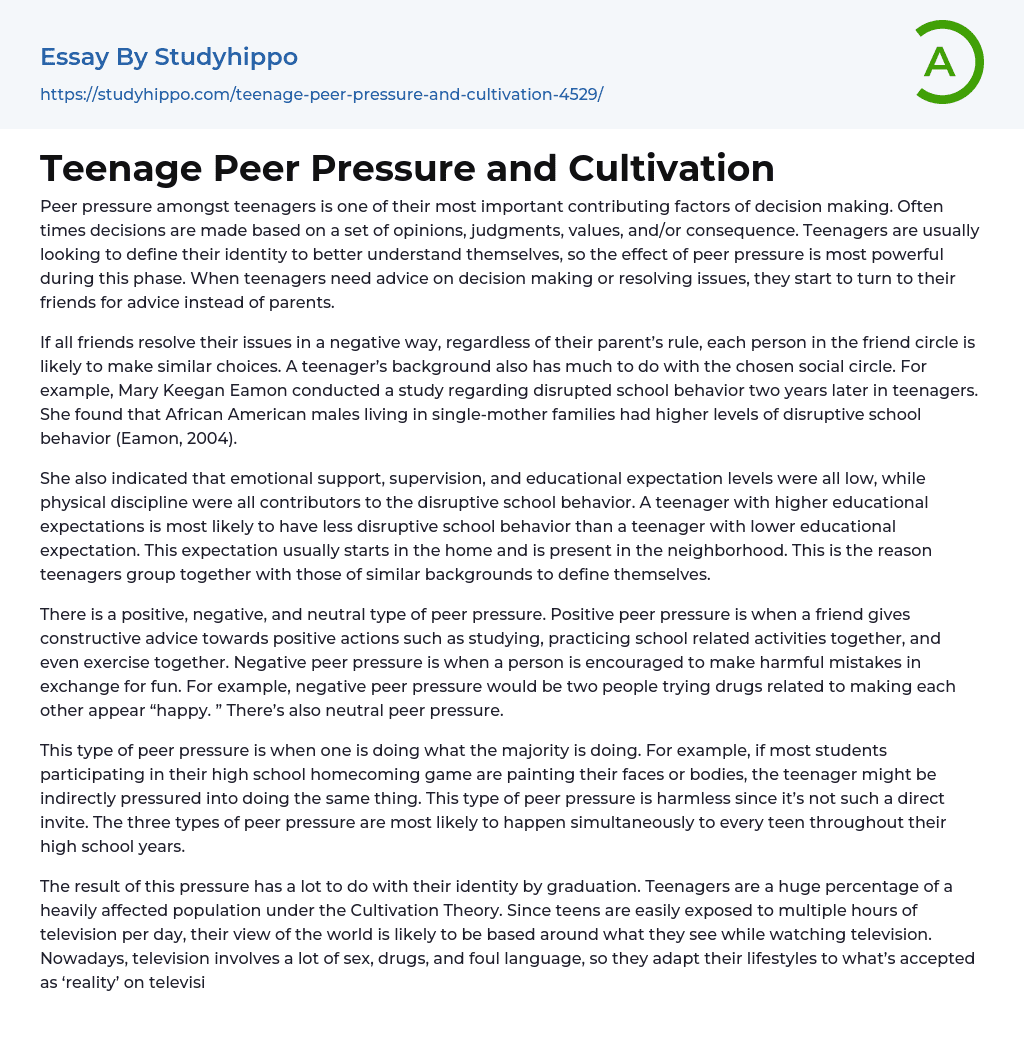Peer pressure amongst teenagers is one of their most important contributing factors of decision making. Often times decisions are made based on a set of opinions, judgments, values, and/or consequence. Teenagers are usually looking to define their identity to better understand themselves, so the effect of peer pressure is most powerful during this phase. When teenagers need advice on decision making or resolving issues, they start to turn to their friends for advice instead of parents.
If all friends resolve their issues in a negative way, regardless of their parent’s rule, each person in the friend circle is likely to make similar choices. A teenager’s background also has much to do with the chosen social circle. For example, Mary Keegan Eamon conducted a study regarding disrupted school behavior two years later in teenagers. She found that African American males living in single-mother families had hig
...her levels of disruptive school behavior (Eamon, 2004).
She also indicated that emotional support, supervision, and educational expectation levels were all low, while physical discipline were all contributors to the disruptive school behavior. A teenager with higher educational expectations is most likely to have less disruptive school behavior than a teenager with lower educational expectation. This expectation usually starts in the home and is present in the neighborhood. This is the reason teenagers group together with those of similar backgrounds to define themselves.
There is a positive, negative, and neutral type of peer pressure. Positive peer pressure is when a friend gives constructive advice towards positive actions such as studying, practicing school related activities together, and even exercise together. Negative peer pressure is when a person is encouraged to make harmful mistakes in exchang
for fun. For example, negative peer pressure would be two people trying drugs related to making each other appear “happy. ” There’s also neutral peer pressure.
This type of peer pressure is when one is doing what the majority is doing. For example, if most students participating in their high school homecoming game are painting their faces or bodies, the teenager might be indirectly pressured into doing the same thing. This type of peer pressure is harmless since it’s not such a direct invite. The three types of peer pressure are most likely to happen simultaneously to every teen throughout their high school years.
The result of this pressure has a lot to do with their identity by graduation. Teenagers are a huge percentage of a heavily affected population under the Cultivation Theory. Since teens are easily exposed to multiple hours of television per day, their view of the world is likely to be based around what they see while watching television. Nowadays, television involves a lot of sex, drugs, and foul language, so they adapt their lifestyles to what’s accepted as ‘reality’ on television.
In social settings, teens form friendships based around common interests such as music, entertainment, sports, recreation, and academics reasons. All common interests can be found on television which could cause a cultivation effect. For example, a group that shares interest in wrestling entertainment may believe that to solve disagreements, one must know how to put the other down by name calling, cursing, and sometimes even attacking people with special moves as their result. This group of friends might not see any wrong doing in their way of solving issues.
In conclusion, the Cultivation Theory
by George Gerbner asserts that television programming creates influential views on the world that can cause a negative view of the world to people in the environment. According to the Cultivation Theory, teenagers who are heavy television viewers probably have a more violent view of the world than those who do not participate in too much television programming. The views come from the tone and attitude in entertainment since most entertainment contain heavy sexuality and violence.
Teenagers form friendships that lead to peer pressure amongst the group. Peer pressure can be positive, negative, neutral, or all in a simultaneous sequence. During high school, most teenagers turn to their peers for emotional support, decision making, and to help solve issues instead of their siblings and parents; this is when the teen is trying to define him or herself while also striving for a sense of independence. Most of the factors that contribute to social groups in teenagers are influenced by television programming of some sort.
Thus, the Cultivation Theory is supported in peer pressure because the characteristics that make up a social group has likely come from an influence on television.
References
- Bernstein, N. (2005, January 25). Sex and peer pressure. MSNBC. Retrieved from http://www. msnbc. msn. com/id/6867362/t/sex-peer-pressure/ Parker, W. (n. d. ).
- Fatherhood. Retrieved from http://fatherhood. about. com/od/dadsandteens/a/teen_friends. htm Eamon, M. , & Altshuler, S. J. (2004).
- Can We Predict Disruptive School Behavior?. Children & Schools, 26(1), 23-37.
- Perseverance essays
- Expressive essays
- Character Traits essays
- Apology essays
- Compassion essays
- Adolescence essays
- Childhood essays
- Growth Mindset essays
- Individual essays
- Infant essays
- Is Google Making Us Stupid essays
- Adult essays
- Aggression essays
- Altruism essays
- Archetype essays
- Behavior essays
- Certainty essays
- Conformity essays
- Deception essays
- Human Behavior essays
- Human Sexuality essays
- Maturity essays
- Morality essays
- Obedience essays
- Procrastination essays
- Reinforcement essays
- Role Model essays
- Ageism essays
- Cultural Diversity essays
- Discrimination essays
- Diversity essays
- Gender Discrimination essays
- Multiculturalism essays
- Oppression essays
- Peer Pressure essays
- Racial Profiling essays
- Sexism essays
- Ambition essays
- Anger essays
- Betrayal essays
- Boredom essays
- Confidence essays
- Courage essays
- Desire essays
- Disgrace essays
- Doubt essays
- Empathy essays
- Fairness essays
- Fear essays
- Feeling essays




